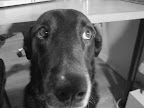Here is one of my favorite songs. It's Queen, of course. "The Millionaire Waltz," from Day at the Races (1976). It's as rhapsodic and rewarding and almost as weird as "Bohemian Rhapsody." How many rock songs are in 3/4? Listen for John Deacon's light touch with the bassline and the way Brian May makes his multitracked guitars sing, and of course, Freddie's command of his range over surgically-executed four-part harmonies. Goddamn, I could listen to this song ten times on a Sunday instead of studying for the bar.
In unrelated news, here is my dad trying to make a phone call to Sears this afternoon. It's not that interesting but some people have been demanding more on this blog about my dad.Also unrelated: I found a book in the trash called "Games for the Super Intelligent," from the 1960s. It's just a bunch of logic puzzles and wordgames along the lines of "What is the next letter in the following sequence: O T T F F S S?"* I leaf through this book when C.H.'s patriotic music stirs and moves my bowels. It is lunacy. I found this part of the preface amusing, though anachronistic:
Some people seem to have a greater talent than others for exercising this sort
of sideways logic - for thinking in quite unexpected and essentially unchartable
ways. Colin Carmichael, writing in the magazine Design, tells the story
- it recalls, in a way, our earlier barometer story - of a class of engineering
students who were given the following question on an exam: How long should a
three-pound beef roast stay in a 325-degree oven for the center to reach a
temperature of 150 degrees? One student, described as a "Big Project Man,"
didn't come up with an answer but did offer a plan for a series of precise
experiments that would yield an accurate answer in six to nine months. Another
student, an advocate of the practical approach, went out and bought a roast, an
oven thermometer, and a watch. He wrote his report while munching medium-rare
roast beef sandwiches. A third student used logic. Reasoning that animal tissue
is mostly water and therefore should have about the same specific heat and
conductivity, he applied heat transfer theory to produce his answer (it proved,
incidentally, to be quite close to that of the second student). The quickest
answer, however, came from a student who called up his mother on the phone and
got the anwer from her. "Which of these men," asked Mr. Carmichael, "Promises to
be the most effective engineer?"
* E, stupid.

No comments:
Post a Comment